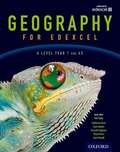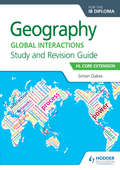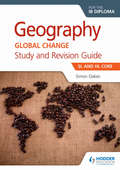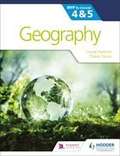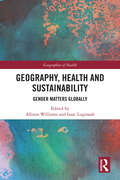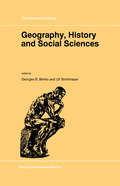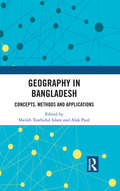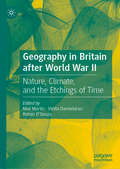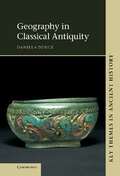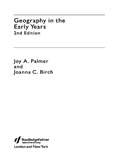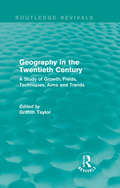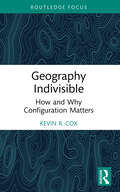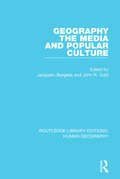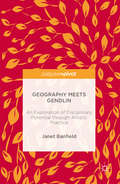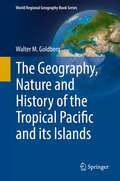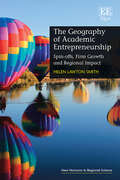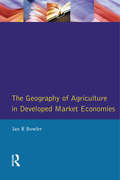- Table View
- List View
Geography for Edexcel A Level Year 1 and AS, Student Book (PDF)
by Bob Digby Lynn Adams Russell Chapman Catherine HurstA student-friendly and engaging textbook for the Edexcel GCE A Level Year 1 and AS specifications. It has been specially written to match the demands of the new specifications and has been endorsed for Edexcel. The coverage of key geographical concepts and processes is accessible and clear, and all your students will be engaged by the interesting, up-to-date examples and case studies - while the rigour, detail, and depth required by the specifications is retainedthroughout. Clearly-written objectives open each section, setting out for students what they need to learn, and high-quality photos, maps, and diagrams aid explanations. Motivating activities, practicequestions, and coverage of the required skills are strong features. The book is completed with a glossary for each chapter and a full index.
Geography for Edexcel A Level Year 1 and AS Student Book (PDF)
by Bob Digby Lynn Adams Russell Chapman Catherine HurstA student-friendly and engaging textbook for the Edexcel GCE A Level Year 1 and AS specifications. It has been specially written to match the demands of the 2016 specifications and has been endorsed for Edexcel. The coverage of key geographical concepts and processes is accessible and clear, and all students will be engaged by the interesting, up-to-date examples and case studies - while the rigour, detail, and depth required by the specifications is retained throughout. Clearly-written objectives open each section, setting out for students what they need to learn, and high-quality photos, maps, and diagrams aid explanations. Motivating activities, exam-style questions, and coverage of the required skills are strong features. The book is completed with a glossary for each chapter and a full index. Answer guidance for the activities is available on Kerboodle (school purchase only).
Geography For Edexcel A Level Year 1 And As Student Book (PDF)
by Bob Digby Lynn Adams Russell Chapman Catherine HurstExam Board: Edexcel Level: A Level Year 1 and AS Subject: Geography First teaching: September 2016 First exams: June 2018 A student-friendly and engaging textbook for the Edexcel GCE A Level Year 1 and AS specifications. It has been specially written to match the demands of the 2016 specifications and has been endorsed for Edexcel. The coverage of key geographical concepts and processes is accessible and clear, and all students will be engaged by the interesting, up-to-date examples and case studies - while the rigour, detail, and depth required by the specifications is retained throughout. Clearly-written objectives open each section, setting out for students what they need to learn, and high-quality photos, maps, and diagrams aid explanations. Motivating activities, exam-style questions, and coverage of the required skills are strong features. The book is completed with a glossary for each chapter and a full index. Answer guidance for the activities is available on Kerboodle (school purchase only).
Geography for the IB Diploma Study and Revision Guide HL Core Extension: HL Core Extension
by Simon OakesStretch your students to achieve their best grade with these year round course companions; provides comprehensive content on all topics, and practice questions to support and strengthen learning. - Develop understanding and knowledge with clear and concise coverage of the syllabus- Target learning with individual books for Standard and Higher level- Consolidate revision and check understanding with a range of exam practice questions- Practise exam technique with tips from examiners throughout on how to tackle questions- Focus revision with key terms and definitions listed for each topic/sub topicAnswers are free online at www.hoddereducation.com/ibextras
Geography for the IB Diploma Study and Revision Guide SL and HL Core: SL and HL Core
by Simon OakesStretch your students to achieve their best grade with these year round course companions; provides comprehensive content on all topics, and practice questions to support and strengthen learning. - Develop understanding and knowledge with clear and concise coverage of the syllabus- Target learning with individual books for Standard and Higher level- Consolidate revision and check understanding with a range of exam practice questions- Practise exam technique with tips from examiners throughout on how to tackle questions- Focus revision with key terms and definitions listed for each topic/sub topicAnswers are free online at www.hoddereducation.com/ibextras
Geography for the IB MYP 4&5: by Concept
by Louise Harrison Thierry TorresDevelop your skills to become an inquiring learner; ensure you navigate the MYP framework with confidence using a concept-driven and assessment-focused approach to Geography, presented in global contexts.- Develop conceptual understanding with key MYP concepts and related concepts at the heart of each chapter. - Learn by asking questions for a statement of inquiry in each chapter. - Prepare for every aspect of assessment using support and tasks designed by experienced educators.- Understand how to extend your learning through research projects and interdisciplinary opportunities.- Think internationally with chapters and concepts set in global contexts.
Geography, Health and Sustainability: Gender Matters Globally (Geographies of Health Series)
by Allison Williams Isaac LuginaahWith a global commitment to achieve gender equality by 2030, the SDGs present a historic opportunity to place gender as central to human progress across the globe. Gender equality, which requires the empowerment of all women and girls, is an explicit goal, in addition to being a fundamental prerequisite to and facilitator of most other SDGs. This edited collection provides a range of geographical and geospatial insights, from a variety of disciplinary and country-specific perspectives, to better understand gender and sustainable development. In addition to several African countries, Mexico, Japan, Canada, USA, and Cambodia are featured. A range of topical case studies examine women’s domestic and care work, including water collection, breastfeeding, food purchasing, and caring for elderly family members. Access to health care services is examined in the case of breast screening and antenatal care. Women’s engagement in the labour force is also addressed, with a specific look at the renewable energy sector; structural barriers to employment are discussed across a number of chapters, with clear strategies to break through these barriers. Finally, theoretical insights are proposed in better understanding and engaging in gendered inequalities in health.
Geography, Health and Sustainability: Gender Matters Globally (Geographies of Health Series)
by Allison Williams Isaac LuginaahWith a global commitment to achieve gender equality by 2030, the SDGs present a historic opportunity to place gender as central to human progress across the globe. Gender equality, which requires the empowerment of all women and girls, is an explicit goal, in addition to being a fundamental prerequisite to and facilitator of most other SDGs. This edited collection provides a range of geographical and geospatial insights, from a variety of disciplinary and country-specific perspectives, to better understand gender and sustainable development. In addition to several African countries, Mexico, Japan, Canada, USA, and Cambodia are featured. A range of topical case studies examine women’s domestic and care work, including water collection, breastfeeding, food purchasing, and caring for elderly family members. Access to health care services is examined in the case of breast screening and antenatal care. Women’s engagement in the labour force is also addressed, with a specific look at the renewable energy sector; structural barriers to employment are discussed across a number of chapters, with clear strategies to break through these barriers. Finally, theoretical insights are proposed in better understanding and engaging in gendered inequalities in health.
Geography, History and Social Sciences (GeoJournal Library #27)
by Georges B. Benko Ulf StrohmayerGeorges Benko «Societies are much messier than our theories of them» Michael Mann The Sources of Social Power 1 Towards a unified social theory Why are there communication problems between the different disciplines of the social sciences? And why should there be so much misunderstanding? Most probably because the encounter of several disciplines is in fact the encounter of several different histories, and therefore of several different cultures, each interpreting the other according to the code dictated by its own culture. Inevitably geographers view other disciplines through their own cultural filter, and even a benevolent view remains 'ethnocentric'. It was in order to avoid such ethnocentricity that Femand Braudel called for more unity among the social sciences in 1958 : «l wish the social sciences . . . would stop discussing their respective differences so much . . . and instead look for common ground . . . on which to reach their first agreement. Personally I would call these ways : quantification, spatial awareness and 'longue duree'». In its place at the center of the social sciences, geography reduces all social reality to its spatial dimensions. Unfortunately, as a discipline, it considers itself all too often to be in a world of its own. There is a need in France for a figure like Vidal de la Blanche who could refocus attention away from issues of time and space, towards space and social reality. Geographic research will only take a step forward once it learns to address the problems facing all the sciences.
Geography in Bangladesh: Concepts, Methods and Applications
by Sheikh Tawhidul Islam Alak PaulThis book provides an overview of the emergence of geography as a discipline in Bangladesh and the contributions made by local geographers towards the development of the country. It explores problems associated with population growth and poverty, landlessness and food security, land use and natural resource management, urbanism, climate change, disaster management and human health. The volume shows how research and the study of geography in the ‘periphery’ can contribute in achieving progress in countries like Bangladesh and help them prepare against imminent disasters, ecological, social, economic shocks and uncertainties. This book will be useful to students and researchers of geography, environment studies, disaster management, development studies, geoinformatics, geology, demography, sociology and South Asian studies with a particular focus on Bangladesh. It will also interest various policy makers and NGO professionals working in these and related fields.
Geography in Bangladesh: Concepts, Methods and Applications
by Sheikh Tawhidul Islam Alak PaulThis book provides an overview of the emergence of geography as a discipline in Bangladesh and the contributions made by local geographers towards the development of the country. It explores problems associated with population growth and poverty, landlessness and food security, land use and natural resource management, urbanism, climate change, disaster management and human health. The volume shows how research and the study of geography in the ‘periphery’ can contribute in achieving progress in countries like Bangladesh and help them prepare against imminent disasters, ecological, social, economic shocks and uncertainties. This book will be useful to students and researchers of geography, environment studies, disaster management, development studies, geoinformatics, geology, demography, sociology and South Asian studies with a particular focus on Bangladesh. It will also interest various policy makers and NGO professionals working in these and related fields.
Geography in Britain after World War II: Nature, Climate, and the Etchings of Time
by Max Martin Vinita Damodaran Rohan D’SouzaContemporary anxieties about climate change have fueled a growing interest in how landscapes are formed and transformed across spans of time, from decades to millennia. While the discipline of geography has had much to say about how such environmental transformations occur, few studies have focused on the lives of geographers themselves, their ideologies, and how they understand their field. This edited collection illuminates the social and biographical contexts of geographers in postwar Britain who were influenced by and studied under the pioneering geomorphologist, A. T. Grove. These contributors uncover the relationships and networks that shaped their research on diverse terrains from Africa to the Mediterranean, highlighting their shared concerns which have profound implications not only for the study of geography and geomorphology, but also for questions of environmental history, ecological conservation, and human security.
Geography In Classical Antiquity (Key Themes In Ancient History Ser.)
by Daniela Dueck Kai BrodersenGeography in the Early Years
by Joanna Birch Joy PalmerThis completely revised and updated second edition of Geography in the Early Years presents a lively and comprehensive overview of teaching and learning in geography. Theoretical aspects of early years teaching in geography are complemented by up-to-date research findings and illustrated with discussion, a wealth of case studies, and suggestions for the development and implementation of sound geographical work in practice. In a practitioner-friendly style, this book provides: an examination of the essence of geography in terms of children's conceptions of the physical environment a detailed description of geography in the national curriculum and of the place and nature of environmental education within early years teaching guidelines for taking a whole school approach in policy, planning and organisation of geographical learning examples of initial teacher training and continuing professional developments. This highly accessible, illuminating book will be immensely helpful to teachers, student teachers, policy-makers and all other providers of education for children aged three to seven years.
Geography in the Early Years
by Joanna Birch Joy PalmerThis completely revised and updated second edition of Geography in the Early Years presents a lively and comprehensive overview of teaching and learning in geography. Theoretical aspects of early years teaching in geography are complemented by up-to-date research findings and illustrated with discussion, a wealth of case studies, and suggestions for the development and implementation of sound geographical work in practice. In a practitioner-friendly style, this book provides: an examination of the essence of geography in terms of children's conceptions of the physical environment a detailed description of geography in the national curriculum and of the place and nature of environmental education within early years teaching guidelines for taking a whole school approach in policy, planning and organisation of geographical learning examples of initial teacher training and continuing professional developments. This highly accessible, illuminating book will be immensely helpful to teachers, student teachers, policy-makers and all other providers of education for children aged three to seven years.
Geography in the Twentieth Century: A Study of Growth, Fields, Techniques, Aims and Trends (Routledge Revivals)
by Griffith TaylorThis title, first published in 1951, examines the growth, fields, techniques, aims and trends of geography at the time. The book is divided into three parts, of which the first deals with the evolution of geography and its philosophical basis. The second is concerned with studies of special environments and with advances in geomorphology, meteorology, climate, soils and regionalism. The last part describes field work, sociological and urban aspects, the function of the Geographical Society and geo-pacifics. Geography in the Twentieth Century will be of interest to students of both physical and human geography.
Geography in the Twentieth Century: A Study of Growth, Fields, Techniques, Aims and Trends (Routledge Revivals)
by Griffith TaylorThis title, first published in 1951, examines the growth, fields, techniques, aims and trends of geography at the time. The book is divided into three parts, of which the first deals with the evolution of geography and its philosophical basis. The second is concerned with studies of special environments and with advances in geomorphology, meteorology, climate, soils and regionalism. The last part describes field work, sociological and urban aspects, the function of the Geographical Society and geo-pacifics. Geography in the Twentieth Century will be of interest to students of both physical and human geography.
Geography Indivisible: How and Why Configuration Matters
by Kevin R. CoxIn a context of disciplinary division between human and physical geography, the book seeks to reassert the unity of the field through an emphasis on a shared focus on the geographic configuration of things and how and why configuration is important. It first examines previous approaches to reestablishing unity, and why they have failed, before moving on to an explanation of fundamental differences in what is being studied and how. The role of configuration looms large in both. This is in the sense of contingency and the idea of emergence, suggesting that reconstruction of unity can proceed through an exchange of models of understanding. This book will appeal to those teaching courses or seminars in geographic thought or in the history of geographic thought.
Geography Indivisible: How and Why Configuration Matters
by Kevin R. CoxIn a context of disciplinary division between human and physical geography, the book seeks to reassert the unity of the field through an emphasis on a shared focus on the geographic configuration of things and how and why configuration is important. It first examines previous approaches to reestablishing unity, and why they have failed, before moving on to an explanation of fundamental differences in what is being studied and how. The role of configuration looms large in both. This is in the sense of contingency and the idea of emergence, suggesting that reconstruction of unity can proceed through an exchange of models of understanding. This book will appeal to those teaching courses or seminars in geographic thought or in the history of geographic thought.
Geography, The Media and Popular Culture (Routledge Library Editions: Human Geography)
by John R. Gold Jacquelin BurgessIn this book, originally published in 1985, British and North American geographers present original and challenging viewpoints on the media. The essays deal with a diverse content, ranging from the presentation of news to the nature of television programming and from rock music lyrics to film visions of the city.
Geography, The Media and Popular Culture (Routledge Library Editions: Human Geography #3)
by John R. Gold Jacquelin BurgessIn this book, originally published in 1985, British and North American geographers present original and challenging viewpoints on the media. The essays deal with a diverse content, ranging from the presentation of news to the nature of television programming and from rock music lyrics to film visions of the city.
Geography Meets Gendlin: An Exploration of Disciplinary Potential through Artistic Practice
by Janet BanfieldThis book makes a timely and engaging contribution to geography’s resurgent interest in art and artistic practice, as well as to growing geographical concerns with embodied or pre-reflective experience. It introduces Eugene Gendlin’s philosophical and methodological work to stimulate geographical thinking and practice, and explores its disciplinary potential through innovative practice-based research into artistic spatial experience. Gendlin’s philosophy and techniques for articulating the pre-reflective are explained and illustrated using artists’ accounts of their practices, both retrospectively and during their practice. The geographical implementation of research methods informed by those techniques is detailed and critiqued. Diverse and potentially contradictory findings, and potentially problematic methodological choices, are discussed, accounted for, and reframed through Gendlin’s ideas. Significant geographical potential within Gendlin’s work—philosophical, conceptual and methodological—is identified and described, and avenues and challenges for further investigation are highlighted. This first step towards a Gendlin-informed geography invites further engagement with his work.
The Geography, Nature and History of the Tropical Pacific and its Islands (World Regional Geography Book Series)
by Walter M. GoldbergThis volume provides an accessible scientific introduction to the historical geography of Tropical Pacific Islands, assessing the environmental and cultural changes they have undergone and how they are affected currently by these shifts and alterations. The book emphasizes the roles of plants, animals, people, and the environment in shaping the tropical Pacific through a cross-disciplinary approach involving history, geography, biology, environmental science, and anthropology. With these diverse scientific perspectives, the eight chapters of the book provide a comprehensive overview of Tropical Pacific Islands from their initial colonization by native peoples to their occupation by colonial powers, and the contemporary changes that have affected the natural history and social fabric of these islands. The Tropical Pacific Islands are introduced by a description of their geological formation, development, and geography. From there, the book details the origins of the island's original peoples and the dawn of the political economy of these islands, including the domestication and trade of plants, animals, and other natural resources. Next, readers will learn about the impact of missionaries on Pacific Islands, and the affects of Wold War II and nuclear testing on natural resources and the health of its people. The final chapter discusses the islands in the context of natural resource extraction, population increases, and global climate change. Working together these factors are shown to affect rainfall and limited water resources, as well as the ability to sustain traditional crops, and the capacity of the islands to accomodate its residents.
The Geography of Academic Entrepreneurship: Spin-offs, Firm Growth and Regional Impact (New Horizons in Regional Science series)
by Helen Lawton SmithBuilding on a variety of contrasting perspectives, this book focuses on the connection between university spin-offs and regional economic development. It aptly captures the diverse range of concepts relating to the main participants in the process of university spin-offs, reflecting on their roles and how these may have changed.This fascinating book provides the reader with an in-depth exploration into the spin-off process, examining how it can begin and evolve over time and how it links to regional development. Chapters highlight pertinent methodological issues previous studies have faced, while putting forward intriguing critiques of the institutional environment. The lifespan and performance of these spin-offs is scrutinised, as well as their operation at different stages of development. Interdisciplinary perspectives are summarised in order to fully investigate the importance of university spin-offs to the economic development of regions.The Geography of Academic Entrepreneurship will be of keen interest to academics within the fields of economic geography and entrepreneurial business, and to those researching technology transfer processes in various national contexts. It will additionally be of great use to postgraduate students researching these processes, as well as policymakers seeking to ascertain how university spin-offs should be comprehended.
Geography of Agriculture in Developed Market Economies, The
by I. R. BowlerFirst published in 1993. Routledge is an imprint of Taylor & Francis, an informa company.
